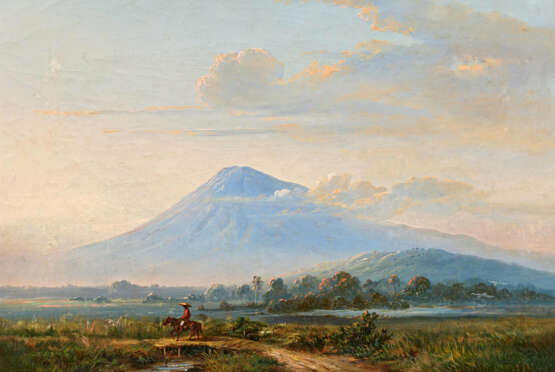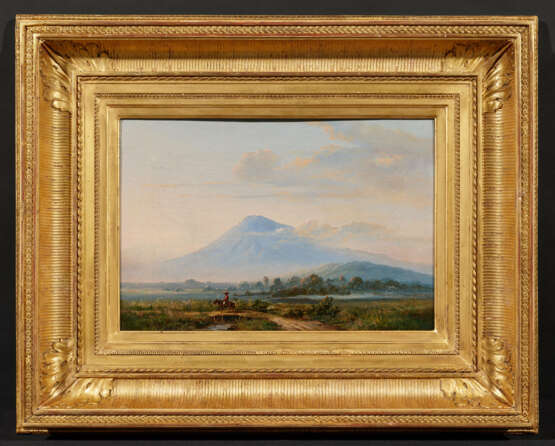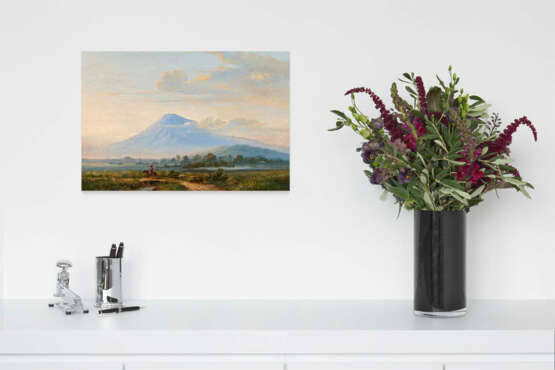Raden Saleh Ben Jaggia. Landscape with a View of the Merapi Volcano on Java
14.11.2024 15:00UTC +01:00
Classic
Prix de départ
40000EUR € 40 000
| Auctioneer | VAN HAM Kunstauktionen GmbH |
|---|---|
| Lieu de l'événement | Allemagne, Köln |
| Commission | 32% |
Archive
La vente aux enchères est terminée. Vous ne pouvez plus enchérir.

ID 1319908
Lot 1341 | Raden Saleh Ben Jaggia. Landscape with a View of the Merapi Volcano on Java
Valeur estimée
€ 40 000 – 80 000
1811 Samarang (Java) - 1880 Buitenzorg
Title:
Landscape with a View of the Merapi Volcano on Java.
Date:
Ca. 1867.
Technique:
Oil on canvas.
Measurement:
30 x 43,5cm.
Frame:
Framed.
Certificate:
Werner Kraus, Passau, 17/07/2024, copy available.
Material analysis:
Art in Lab, Paris, 12/06/2024, copy available.
The painting was subjected to the following analyses in May-June 2024 Examination with ultraviolet light, digital microscope, X-ray fluorescence spectroscopy (SFX), and Fourier transform infrared spectroscopy (FTIR). These analyses show that the pigments match the biographical data of Raden Saleh (1811-1880) and indicate that the work was created in the years 1850-1860.
Provenance:
Private ownership, France;
Art market, London (as 'Dutch School');
Art market, Belgium (as 'Calame Umkreis').
Mount Merapi, literally meaning fire mountain, is one of the most active volcanoes on the island of Java. Its Javanese name is derived from Meru, the exemplary centre of Hindu and Buddhist cosmology, and api, which means fire. Its name alone makes it the imaginary centre of the world, the pivot and nail in the universe.
For millions of years, the periodic eruptions of the volcano have supplied the soil in its immediate vicinity and in neighbouring areas with abundant mineral nutrients. At the same time, its gentle slope, which extends to the southern sea, enabled the establishment of complex and extensive irrigation systems, which formed the basis for the successful cultivation of wet rice. The resulting agricultural wealth was in turn the basis for the establishment of local states and the adoption of more complex Indian-style administrative and religious structures. Witnesses of the resulting Hindu-Javanese high culture, namely architectural and sculptural highlights such as the temple complex of Prambanan or the Buddhist stupa of Borobudur, still inspire us today. No economic, political and cultural developments would have been possible without the central role of the Merapi volcano. It is the main player in this system, which is emphasised by its central position in Javanese state theory and mythology to this day. Merapi is not just one of many mountains of fire on the island: it is the central mountain.
This central significance of the volcano found its way into the state theory of the Kingdom of Mataram and its successor states. The rulers of these political entities saw and still see themselves as mediators between the spiritual representation of the mountain and that of the Southern Ocean, a role that guarantees the fertility and well-being of the land and its inhabitants. A significant part of their legitimisation stems from this understanding.
Men as diverse as the brilliant geologist Wilhelm Junghuhn and the painter Raden Saleh understood this central importance of Merapi in Javanese culture. Junghuhn, who climbed and described all 43 volcanoes in Java, began with Merapi in 1838, and Raden Saleh painted no other mountain in Java with the same attention and precision as Merapi.
The Merapi volcano can be found as a motif in at least 12 paintings by Raden Saleh. In most of these paintings, the mountain is the central theme; one could almost speak of 'portraits' of Merapi. Unlike the mountains around Bogor, such as Gunung Salak, Gunung Gedeh and Gunung Pangerango, which often appear as backgrounds in his West Javanese landscape paintings, Raden Saleh (mostly) depicts Merapi as a solitaire. This indicates that he was aware of the mystical significance, the sublimity, of the mountain and expressed this in his painting.
In 1865, Raden Saleh decided to spend some time in Central Java. There were various reasons for this. Firstly, he planned the trip for artistic reasons - he wanted to broaden his view of Java's landscape. While he had previously mainly used West Javanese landscapes as motifs, he now wanted to expand his spectrum to include the rice plains, volcanic cones and temple ruins of Central Java. In addition to this basic motif, however, he was also driven by the hope of finding a suitable wife in Yogyakarta. His marriage to Constantia von Mansfeld had foundered on the rocks of colonial racism and Raden Saleh wanted to put down new roots in his homeland. In doing so, he endeavoured to distance himself to a certain extent from the colonial inventory. A Javanese woman with an aristocratic background would have been very helpful.
However, travelling from Batavia to the principalities (Central Java) was not easy. Permission from the authorities was needed, i.e. a passport, and this was only available if you could provide convincing reasons for the journey. Saleh had already applied for such a trip to Central Java in 1855, ten years earlier, to make studies for his painting 'Arrest of Diponegoro'. However, the government was not convinced of the necessity of this trip and rejected the request.
Ten years later, he tried again to obtain a travel permit and this time he was less naive in his dealings with the administration. Saleh skilfully offered his services to the Bataviaasche Genootschap van Wetenschappen en Kunsten as a procurer of Javanese manuscripts. Stuart Cohen, a board member of the Genootschap (and one of the pioneers of Dutch Javanology), knew that the Javanese were extremely reluctant to part with old manuscripts, which they generally regarded as pusaka (heirlooms with magical powers). He found the idea of utilising Raden Saleh's services as a cultural broker very charming.
The board of the Genootschap therefore submitted a travel application with free use of post horses for Raden Saleh, which was approved by the government in May 1865. This cleared all obstacles out of the way and Raden Saleh was soon on his way. He arrived in Yogyakarta in August 1865.
Between October and December 1865, the Merapi volcano was in a very active phase. Endless clouds of smoke and ash rose into the sky and millions of cubic metres of lava flowed over the crater rim. Raden Saleh climbed the smoking and rumbling mountain with a group of Dutchmen and local dignitaries and captured the magnificent natural spectacle on two canvases - Merapi erupting by day and Merapi erupting by night. He would later produce three replicas of this highly successful pair.
Today, these depictions of the erupting Merapi volcano are among his masterpieces. However, we are also familiar with his paintings that show Merapi as a source of fertility and a symbol of universal harmony. In this case, the mountain is enthroned in the centre of the picture, surrounded by rice fields (if painted from the south) or untouched nature (if painted from the north or east).
One of these 'portraits' of Merapi (and its twin mountain Merbabu) was painted in 1867 and exhibited at the famous Internationale Koloniale en Uitvoerhandel Tentoonstelling in Amsterdam in 1883. The painting was entitled 'Gezicht op den Merapi en Merbabu'. Unfortunately, we have no information about the current owner of this painting, nor do we know of any image of it.
Also, there are several other Merapi paintings, two of which date from 1871, both of which are accurate depictions of the volcano from different angles, and the first in particular (Merapi with rice fields) is somewhat reminiscent of the present painting.
Raden Saleh's depictions of Merapi have a different quality to his landscape paintings from West Java. The majesty of the Javanese central volcano has a great effect on the painter, and this appears clear and powerful on his canvases.
Even after almost 170 years, Werner Kraus feels touched when looking at his Merapi pictures and is reminded of the ingenious mountain poem by Li Bai (701-762), which Günter Eich translated so congenially. Translated into English it says:
A flock of birds, high flight vanished.
An orphaned cloud that fled away.
We both felt no weariness,
To look at each other, the mountain and I.
After this, admittedly overlong introduction, back to the subject, back to the painting 'Gunung Merapi and Rider', which clearly bears Raden Saleh's artistic signature, and which Werner Kraus considers to be an original painting by Raden Saleh.
The central theme of the painting is the recognisable volcano Gunung Merapi. Its imposing structure and the sky take up more than two thirds of the painting, as we know it from classical Dutch landscapes, but also from Caspar David Friedrich, whose paintings Raden Saleh must have seen in Dresden. There, too, the sublimity is created by oversized skies. There is a light mist over parts of the landscape and a morning mood prevails. The light comes from the left. The only person in the picture is riding a small Javanese horse over a simple bridge: A small person in the overwhelming grandeur of nature. A stream coming from the mountain divides the foreground. Rice grows in the fields to his left and right. The trees and the hill in the middle ground are blurred and insignificant and in no way compete with the grandeur of the mountain.
Since this work, like several other paintings by Raden Saleh, is not signed, we must use other parameters in addition to a trained eye to determine its authorship. It has already been explained that Raden Saleh spent time in Central Java (Yogyakarta) between 1865 and 1868 and that he had the Merapi constantly before his eyes. Werner Kraus dates the painting to 1867, the year in which the mountain was peaceful and inactive after a previously very active phase. But of course, the picture could also have been painted a few years later, between 1867 and 1871, based on existing sketches.
| Artiste: | Raden Saleh (1811 - 1880) |
|---|---|
| Technique appliquée: | Huile |
| Catégorie maison de vente aux enchères: | Peintures de maîtres récents |
| Artiste: | Raden Saleh (1811 - 1880) |
|---|---|
| Technique appliquée: | Huile |
| Catégorie maison de vente aux enchères: | Peintures de maîtres récents |
| Adresse de l'enchère |
VAN HAM Kunstauktionen GmbH Hitzelerstr. 2 50968 Köln Allemagne | ||||||||||||||
|---|---|---|---|---|---|---|---|---|---|---|---|---|---|---|---|
| Aperçu | |||||||||||||||
| Téléphone | +49 221 92586215 | ||||||||||||||
| Fax | +49 221 92 58 62 4 | ||||||||||||||
| Commission | 32% | ||||||||||||||
| Conditions d'utilisation | Conditions d'utilisation | ||||||||||||||
| Heures d'ouverture | Heures d'ouverture
|






